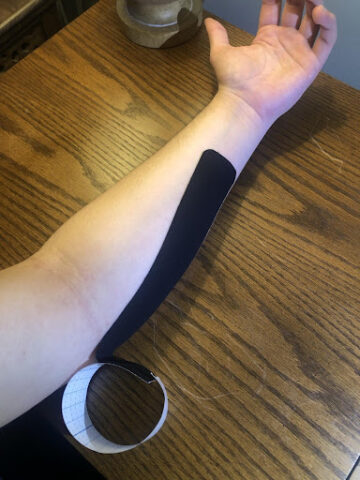by Mateo Estanislao
Kinesiology Tape is often referred to as Kinesio Tape, K Tape, and KT Tape. It is also marketed under brand names like RockTape, Spider Tech, and Mueller. For the purpose of this article, I will be using the term “KT Tape” because it is the best known brand and it’s easily recognizable. However, most varieties of kinesiology tape are interchangeable for these applications and depend on personal preferences. I’d also like to make it very clear that my writing is not medical advice or a professional opinion in any form. This is the culmination of my experience over the past four months of using KT Tape in my college auditions, orchestra rehearsals, private lessons, and regular practice. KT Tape is another tool that can be used by musicians to help us be more productive and efficient with our time.
KT Tape is an elastic fabric strip that adheres to the skin. It was designed to help muscle contraction and function similarly to our own skin. When the tape is applied directly to the skin, the tension causes a response from the body to contract the muscles around the tape. This has the added effect of stimulating more blood to the area, which can reduce inflammation and pain. Essentially, KT Tape can assist movement, joint stability, and recovery by stimulating a natural response from the human body. The product does not provide a significant amount of support to prevent injury, but it can enable the body to support itself better.
It is best to apply KT Tape after a hot shower to ensure the natural oils on the skin don’t interfere with the adhesive on the tape. The heat from the hot water will help the adhesive stick to the skin better, allowing the tape to function for a longer period of time. Skin irritation is a possibility if KT Tape is used for an extended period of time, but each person reacts differently to the adhesive. I usually leave the tape on for three days and have at least a day between each application of the tape to prevent any irritation. Each person should find a routine that works for them and their skin. If skin irritation is a significant problem, there are many varieties of KT Tape designed for sensitive skin and have alternative adhesives or fabrics that may work better for some people.
Due to the properties of KT Tape, I’ve found that it’s most effective at reducing the time it takes to properly warm up and keeps the muscles warm during breaks in playing. This has been incredibly helpful in the past few months of auditions because each school varies in the amount of time they give you to warm up. I’ve auditioned at a school that only gave me ten minutes, but another school gave me over an hour in my own practice room. KT Tape allowed me to focus on getting in the right headspace for the audition and finding my sound, rather than being completely cold and rushing through my warm up time. Some of the benefits of KT Tape are psychological, but if using the tape makes me feel more confident going into an audition, then that’s all the justification I need to keep using it.
KT Tape is most beneficial when applied to areas that require constant engagement to play an instrument. The tension applied with the tape should work with the position your body is in while playing. I’ve found that using less tension often works better for me because of my tendency to over-play and press. With too much tension, the tape can actually be counterproductive and overstimulate the muscles. This can cause some pain, so be mindful of how KT Tape is affecting your body if you use it. With lower tension, the tape increases the blood flow and prevents muscles from getting too cold.
Occupational Therapists are trained in applying KT Tape to be as effective as possible, so seeing an OT is really the best option to ensure the tape is working with your instrument and body. However, if you know what specific muscles or tendons are injured, then it’s relatively easy to apply the tape yourself or with the help of someone else. There are many video tutorials on YouTube that go through the process step-by-step and are really easy to follow.
This is how I apply the tape myself for medial epicondylitis, more commonly known as Golfer’s Elbow:
- Tear the paper and inch from the end of the strip.
- Apply about one inch of the tape without any stretching. This is referred to as an “anchor” for the tape.
- Gently stretch the tape and lay the strip down over the area of concern. My tape covers the flexor muscles in my forearm and the point where the medial tendon connects to my elbow.
- Peel off the rest of the paper and apply the last inch of tape as the second anchor. To make sure the tape adheres well, rub the entire piece of tape to heat up the adhesive. This will help the tape last longer and prevent the ends of the tape from curling prematurely.
Using KT Tape has helped me immensely over the last few months. My warm up routine used to be a huge time commitment that, occasionally, made me really frustrated with myself. While I still foam roll and stretch to ensure my tendinitis doesn’t relapse, it’s not necessary for me to practice pain free anymore.
In all of my college auditions, I was able to fully warm up and get mentally prepared in only fifteen minutes. I focused on stretching my arms and shoulders, bowing open strings, and playing the first two measures of every piece for the audition. Then I could focus on breathing, calming my racing heart, and getting set to perform. This helped me succeed in all of my auditions and share my own music with everyone I played for.
KT Tape is an incredible resource for musicians and I can’t recommend it enough. It has been so helpful by allowing me to use my time more effectively. After long car rides to lessons, rehearsals, and auditions, I’d usually be completely cold. KT Tape prevents my arms from getting too stiff and keeps me ready to play. This isn’t a magic solution to preventing another injury, but it’s helped me stay healthy and perform at my best.
Images
Mateo Estanislao



